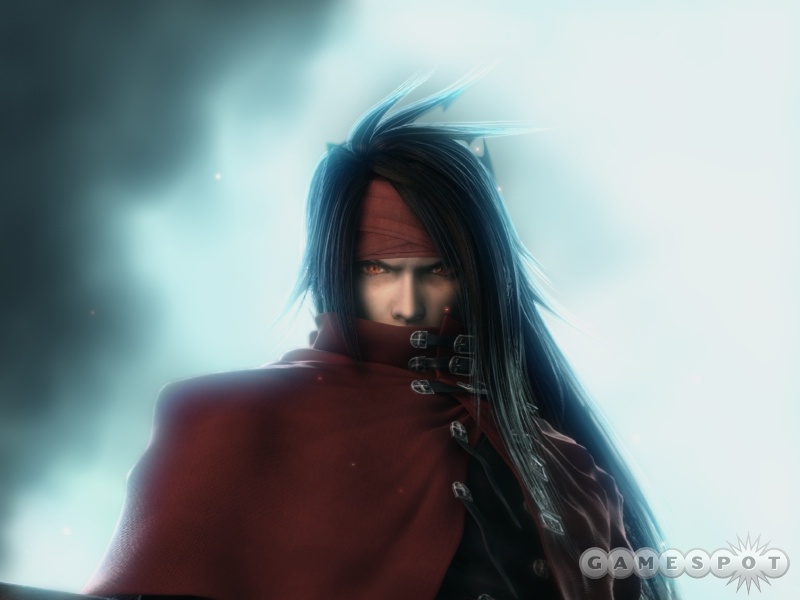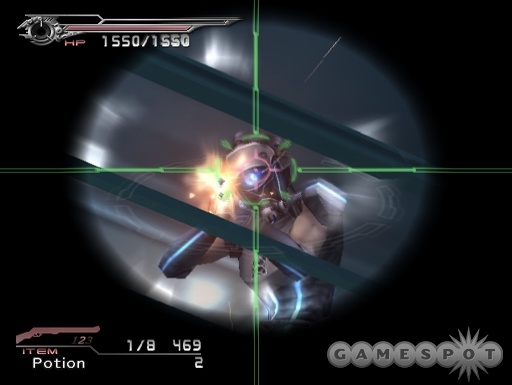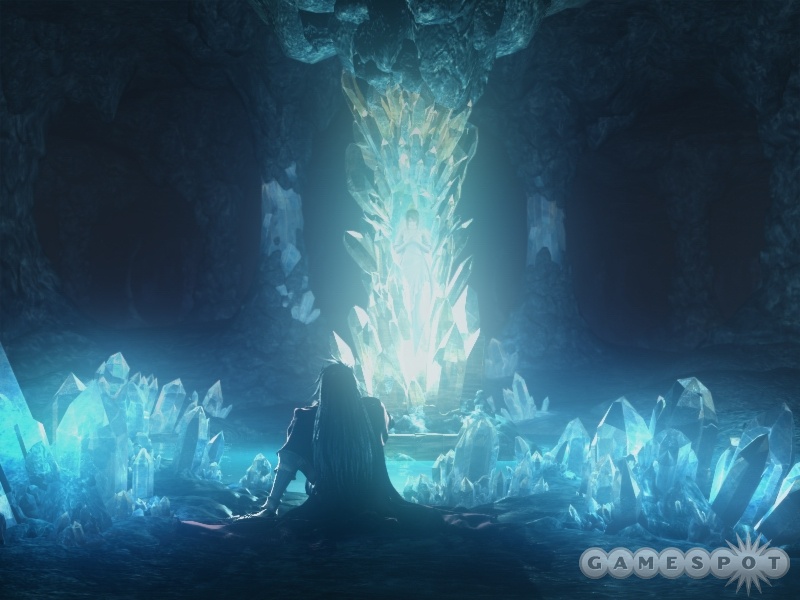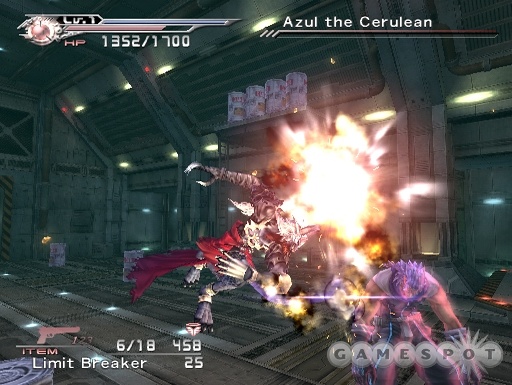It's difficult not to have high expectations of a game that carries the title of one of the most popular and beloved video games ever made, so right from the start the odds are stacked against Dirge of Cerberus: Final Fantasy VII. It also doesn't help that the game eschews its role-playing roots in favor of a generic third-person shooter design. If you're looking for another character-driven epic that lives up to the Final Fantasy VII name, you'll be disappointed with Dirge of Cerberus. If you could care less about all that and are just looking for a mindless action game to blast through in a weekend or two, you can find some moderate enjoyment in Dirge of Cerberus. But in a market that is filled to bursting with great action games, it takes more than some mediocre gunplay and Final Fantasy window dressing to make a game worth your time and money.

In Dirge of Cerberus you play as Vincent Valentine, an immortal gunslinger with a dark past. Three years after Cloud, Vincent, and friends saved the world from total annihilation, people have started to put the pieces of their lives back together. But there's more trouble in store: A group of elite soldiers known as Deepground have plans to revive the Omega weapon and destroy the world. However, they need Vincent in order to do so. It's your job as Vincent to save the world once again while uncovering the secrets of your past to discover why you play such an important role in Deepground's scheme. The story gets convoluted at times, especially when new characters are introduced; nevertheless, it's an interesting look at the origins of one of the more endearing supporting characters from Final Fantasy VII. Some familiar faces do show up in a couple of cutscenes, but for the most part Dirge of Cerberus tells a self-contained story that is separate from that of Final Fantasy VII.
The game plays out in the standard mission-based format. You usually have to watch a lengthy cutscene to set up each stage, then you enter the stage and start blasting your way down a very linear path from the start of the level to the end, where you usually encounter a boss of some sort. The general goal is to kill everything that moves, but sometimes you'll trigger mission events, which present you with a more immediate goal, such as to protect all the civilians in the vicinity, or to disarm the hidden mines in a room. These missions are optional, but by completing them you'll earn extra points that can be used to level up Vincent between stages, or to purchase weapon upgrades and items. The missions do make the levels a bit more interesting by giving you something to do beyond just running down what feels like a long hallway and shooting the same enemies over and over again. Unfortunately, the missions are few, so you're left to simply run and shoot your way through about a dozen bland, repetitive levels.
The stages will take you to some familiar places, such as Shinra Manor and the famously destroyed city of Midgar. But even if you've played Final Fantasy VII extensively, you won't ever feel like you're in the same world here. The backgrounds are all bland and unassuming, with a lot of overused scenery that will make you feel as though you're seeing the same exact room or hallway again and again throughout each stage. There's a bit more variety from stage to stage, but all of the levels are so linear and confined that even if you wanted to explore the environment, you couldn't get very far. There's also very little interaction with your surroundings, which furthers the sterile feel of each level. You'll see a box or barrel here and there that can be destroyed, but you'll also see open doorways that are blocked by out-of-place laser-beam barriers, ledges you can't jump to, small objects that you can't leap over, and a lot of very dull scenery.
With such uninteresting stages the focus is on the action, which is unfortunate because the action isn't terribly exciting, either. The game controls much like a first-person shooter, with the left analog stick being used for movement, and the right analog stick being used to aim. The controls work fairly well, and it's easy to strafe around a target while keeping your aim steady. The shooting is made easier by an optional targeting support feature that will snap your aim to the nearest available target. Using the targeting support you can pick off enemies one after the other without any trouble at all. In and of itself, the dual analog control scheme works just fine, but with the narrow corridors and cramped spaces of many of the levels, the camera becomes a hassle. The camera is positioned behind the back of Vincent, and when you move the right analog stick the camera follows. This is fine when you're out in the open, but when you're in a tight hallway the camera doesn't have anywhere to move, and instead gets right up in the back of Vincent's head. There is a pseudo-first-person view that you can switch to as long as you don't have a sniper scope equipped, but it's obviously not intended to be used for extended play because actions such as performing a melee attack will automatically pull you out of this view. The game does include the option to use a PlayStation 2-compatible USB mouse and keyboard to make the controls more akin to a PC first-person shooter, but with the built-in aim assist in the game, the extra accuracy provided by the mouse is unnecessary.

The gunplay in Dirge of Cerberus is functional, but it isn't especially satisfying. The enemies you face are mostly generic soldiers and dogs, with a few mechs and flying creatures thrown in from time to time. More often than not the soldiers will leap from behind some boxes as you enter a room, but sometimes they'll try to snipe you from the top of a building. All of the enemy behavior in the story missions is scripted, so you'll always see the same enemies in the same places, and their behavior quickly becomes predictable. You can usually take down an enemy with a single shot, or perhaps three shots at the very most. That means that even if the enemy artificial intelligence were halfway decent, you'd never know it, because the enemies don't stick around long enough to do anything but die. There are several boss battles in the game, but most of these battles play out like any other gun fight, except they last longer because the bosses tend to have thousands of hit points rather than hundreds.
Beyond the generic enemies, the gunplay is hampered by a disappointing selection of weapons. In a game that is entirely about running and shooting, it would be nice to have more than a few guns to play with. The most useful weapon by far is the Cerberus pistol, which can be upgraded to do more than enough damage to take out any enemy, and can even be outfitted with a scope and long barrel to be used for sniping. You can easily use the Cerberus for the entire game, only switching weapons when you run out of ammo. To its credit, the game features a fairly in-depth weapon upgrade system. You can use gil you've collected to purchase new parts for your weapons, which changes parameters such as weight, power, and range. But even with a fully upgraded weapon, you'll still feel like you're using a popgun to shoot paper targets.

Things do get a bit more interesting when you start to use magic and limit breaks. You can collect or purchase a few different types of materia that you can equip to your weapon. As long as you have enough magic points, you can press L1 to fire a magic shot that will usually inflict more damage over a larger area than a normal shot. The problem is that you only get two or three magic shots out of a full magic gauge, so you have to use the magic sparingly. You can also pick up items called limit breakers, which can be used to make Vincent transform into a bipedal beast that can hurl magic and inflict heavy damage with its claws. The limit break lasts only a limited time, but that's usually more than enough to bring down a boss or clear an area of enemies. The magic and the limit breaks add a welcome twist to the otherwise very standard run-and-gun design of the game, but they also feel ancillary and unnecessary, because you can play almost the entire game without ever using them.
One area where Dirge of Cerberus shines is in its prerendered cutscenes, which look every bit as amazing as the Advent Children movie. Unfortunately, there aren't very many of these, but you'll probably want to watch each one several times. There are a ton of in-game cutscenes as well, which don't look nearly as good. These cutscenes do usually look fairly decent, though, if only because they focus on the characters, which look detailed and lifelike, despite their often rather garish appearances. Some of the in-game cutscenes drag on way too long, and they're full of heavy, melodramatic dialogue that can be painful to listen to. The greater problem with the cutscenes is that they're used so frequently that they interrupt the pace of the game. Often cutscenes will take place right in the middle of a level, so you'll play for a few minutes, then watch a lengthy cutscene, then play for a few more minutes and do it all again. What's worse is that each cutscene comes with a lengthy load time, and sometimes it's so bad that the game will pause at the end of one scene and then take several seconds to load another short, 10-second clip.
All of the cutscenes are fully voiced, and although the voice acting is usually too weighty to sound natural, it fits the tone of the game. The music varies with each level and ranges from quiet, almost nonexistent ambient tunes to dramatic, orchestrated tracks that do a great job of supporting the action. There's also a high-energy theme song from Japanese pop star Gackt that plays during the end credits. But beyond that, the sound is a bit weak. The light pop of Vincent's guns won't exactly imbue you with a sense of power, and some of the explosion sound effects sound distorted.

It will take you roughly 10 hours to complete the story in Dirge of Cerberus, but, oddly enough, the game actually gets better after the credits roll. When you beat the game, you unlock more than 45 extra missions that have you doing things like battling bosses, defeating 100 enemies using only magic, or shooting your way through a maze to reach a goal point as quickly as possible. There's a decent amount of variety to these missions, and they're usually much more fun and challenging than the story missions. So if you can settle for some underwhelming shooting just to get your Final Fantasy fix, you'll find a lot of content among the multiple difficulty settings and extra missions to keep you busy for quite awhile. The multiplayer mode that was in the Japanese release of the game has been stripped out of the North American release, but given that it required players to use the PlayOnline service and own a PlayStation 2 hard drive, it doesn't seem like much of a loss.
Dirge of Cerberus: Final Fantasy VII presents a difficult choice to Final Fantasy fans. On one hand, it's a generic shooter that simply doesn't measure up to the high standards for action games on the PlayStation 2. On the other hand, it's a new entry in the beloved Final Fantasy VII universe, so if you're a fan of that game you might feel almost obligated to play this one, even though the story contains very little of what made the original game so great. The end result is a game that does have a few interesting and even entertaining moments, but will ultimately leave action game fans and Final Fantasy fans feeling unfulfilled.



